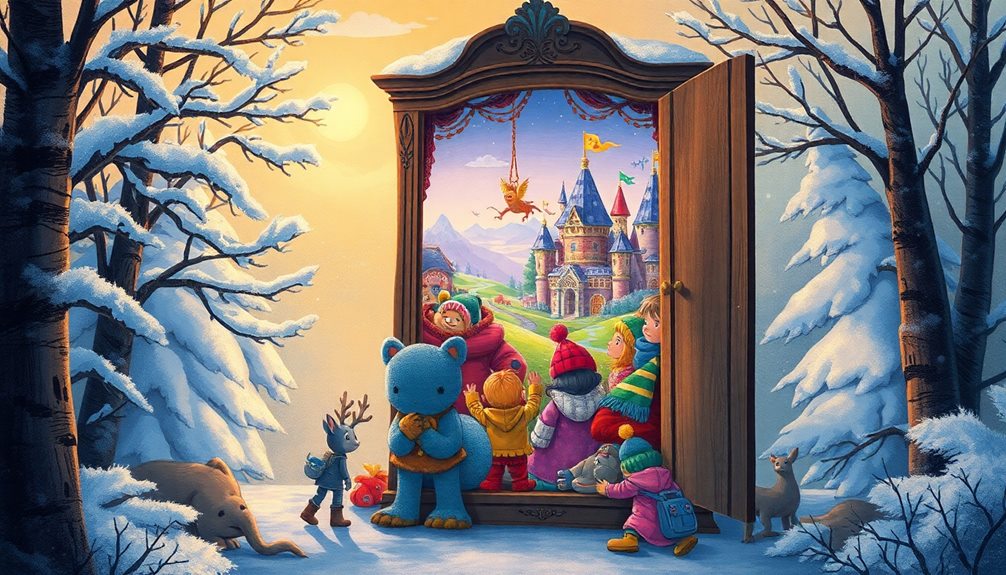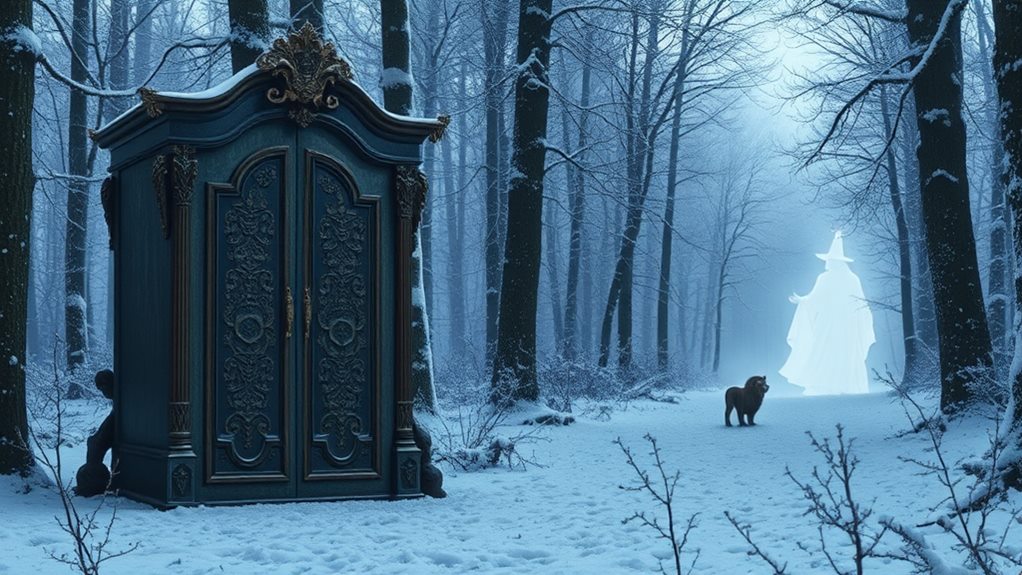"The Lion, the Witch, and the Wardrobe" tells the enchanting story of four siblings who stumble into Narnia through a wardrobe. In this magical domain, they encounter a fierce battle between good and evil, led by Aslan, the noble lion, against the wicked White Witch. Each sibling faces unique challenges, with Edmund's betrayal highlighting themes of redemption and courage. As they unite to defeat the Witch, their journey reflects deeper messages of sacrifice and hope. This classic tale not only captivates but also inspires. If you're curious about the characters and themes, there's so much more to uncover.
Overview of the Story
In "The Lion, the Witch, and the Wardrobe," you follow the adventures of four siblings—Peter, Susan, Edmund, and Lucy Pevensie—who are evacuated from London during World War II. Their journey begins when Lucy discovers a magical land called Narnia through a wardrobe. In Narnia, she meets Mr. Tumnus, a faun, and learns about the oppressive rule of the White Witch, who's cast a spell of eternal winter over the land.
The story is deeply rooted in the concept of Deep Magic's influence, which governs the balance and order within Narnia.
As the story unfolds, Edmund betrays his siblings by siding with the Witch, lured by promises of power and enchanted Turkish Delight. However, a prophecy foretells that the siblings are destined to assist Aslan, the true king of Narnia, in reclaiming the land from the White Witch.
Aslan's sacrifice for Edmund's betrayal serves as a turning point in the tale, ultimately leading to his resurrection.
The siblings unite with Aslan and their allies in a climactic battle against the White Witch. Victorious, they're crowned as the rightful rulers of Narnia and enjoy a peaceful reign, before returning to their world, forever changed by their adventures in this classic fantasy.
Key Characters and Their Roles
The Pevensie siblings are central to the unfolding drama in "The Lion, the Witch, and the Wardrobe," each representing distinct virtues and flaws that shape their journeys.
Lucy, the youngest, is the first to discover Narnia. Her innocence and openness to magic lead her to befriend Mr. Tumnus, a faun who embodies kindness. In a way reminiscent of the character development in David Copperfield, the siblings' experiences highlight themes of personal growth and resilience as they face adversity.
Edmund, on the other hand, initially betrays his siblings by siding with the White Witch, driven by greed. His journey highlights the themes of redemption, as he ultimately seeks forgiveness and reconciles with his siblings.
Peter, the eldest, shows remarkable bravery and leadership, becoming the High King of Narnia. He plays a significant role in the battle against the White Witch, symbolizing courage and responsibility.
Aslan, the great lion, serves as a Christ-like figure throughout their adventure. His self-sacrifice for Edmund showcases his embodiment of good and redemption, as he ultimately leads the fight against evil in Narnia.
Together, the Pevensie siblings navigate challenges and growth, each contributing uniquely to the rich tapestry of this enchanting tale.
Major Themes and Symbolism

Good vs. evil stands at the heart of "The Lion, the Witch, and the Wardrobe," driving the narrative forward and shaping the characters' destinies. The conflict between Aslan and the White Witch exemplifies this struggle, representing the fight for Narnia's freedom. Aslan's self-sacrifice at the Stone Table serves as a powerful symbol of redemption and resurrection, echoing Christian themes of atonement.
This struggle mirrors the resilience displayed by characters in other narratives, such as Liesel Meminger in Nazi Germany's oppression, where acts of courage illuminate the battle against evil.
The concept of prophecy plays a significant role as the Pevensie siblings fulfill their foretold destiny to restore peace in Narnia. The wardrobe acts as a gateway to imagination and adventure, inviting you to explore the transformative power of belief.
Through this journey, you see how the characters confront moral complexity, particularly in the case of Edmund, who embodies betrayal but ultimately finds redemption.
These themes intertwine, enriching the narrative and prompting you to reflect on choices, consequences, and the nature of good vs. evil. The allegorical elements invite deeper understanding, making you consider how the struggles in Narnia mirror those in our own world, and highlighting the importance of courage, loyalty, and hope in the face of darkness.
Reception and Adaptations
Since its publication in 1950, "The Lion, the Witch and the Wardrobe" has garnered widespread acclaim, cementing its place as a classic in children's literature. The story of Peter and Susan, along with their siblings, captivated readers with its enchanting portrayal of a magical world ruled by the White Witch.
Its positive reception led to sequels, further enriching the Narnia series and ensuring its status as a timeless classic. The novel's themes of identity and self-discovery resonate with audiences, much like the transformative journeys found in other literary works.
Over the years, this beloved tale has inspired numerous adaptations. Notable examples include a 1967 10-part television serial, a 1979 animated movie, and a 1988 BBC adaptation that combined live-action and puppetry.
A stage adaptation premiered in 1984 at London's Westminster Theatre, followed by a musical version in 1986. The most prominent film adaptation, released in 2005, co-produced by Walt Disney Pictures and Walden Media, grossed over $745 million worldwide and set the stage for sequels like "Prince Caspian" and "The Voyage of the Dawn Treader."
The ongoing popularity of Narnia has led to recent adaptations, including a West End production that ran from 2021 to 2023, delighting audiences with its impressive cast and performances.
Writing Process and Illustrations

Inspired by a vivid childhood image of a faun in a snowy wood, C.S. Lewis initiated the writing process for *The Lion, the Witch, and the Wardrobe* in late September 1939. Drawing inspiration from the experiences of evacuated children during WWII, he completed the manuscript by March 1949.
This period of upheaval and uncertainty parallels the themes present in many historical narratives, where characters often embody empowering narratives and themes of resilience and courage. However, delays in publication meant it wasn't until October 16, 1950, that the book was released by Geoffrey Bles.
To enhance the story, Lewis chose illustrator Pauline Baynes, thanks to a recommendation from J.R.R. Tolkien. The original British edition featured 43 intriguing illustrations that brought Narnia to life.
In contrast, the American editions released by Macmillan in 1950 included fewer illustrations and underwent text resets, altering some aspects of the narrative.
Fortunately, HarperCollins later adopted the original British edition for their English publications, preserving Baynes' enchanting illustrations. This collaboration between Lewis and Baynes not only enriched the reading experience but also solidified the book's enduring legacy in children's literature.
Through their combined efforts, the fantastical world of Narnia has continued to fascinate readers for generations.
Conclusion
In summary, "The Lion, the Witch, and the Wardrobe" captivates readers with its rich storytelling and timeless themes. Did you know that the book has sold over 85 million copies worldwide? This classic continues to inspire generations, inviting you to explore the magical land of Narnia and its unforgettable characters. As you journey through its pages, you'll discover the power of courage, sacrifice, and the enduring battle between good and evil. Immerse yourself in this enchanting tale today!



